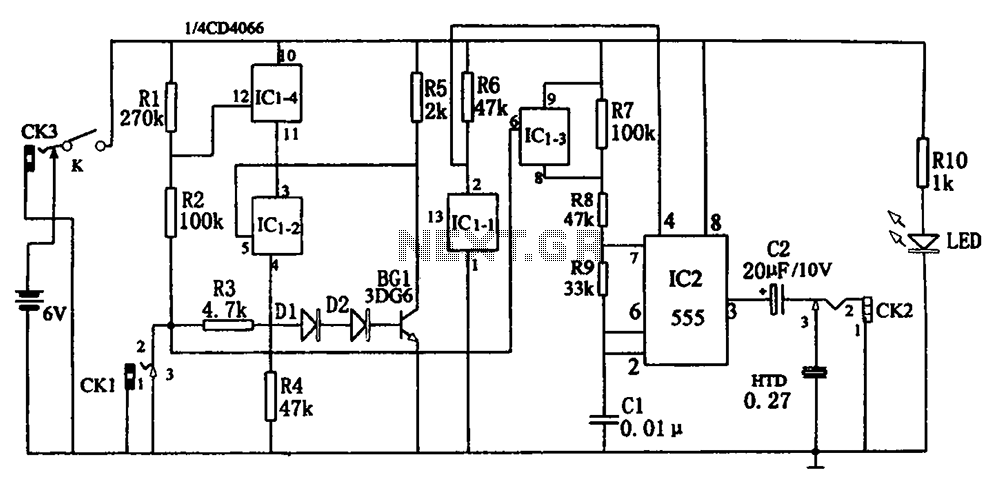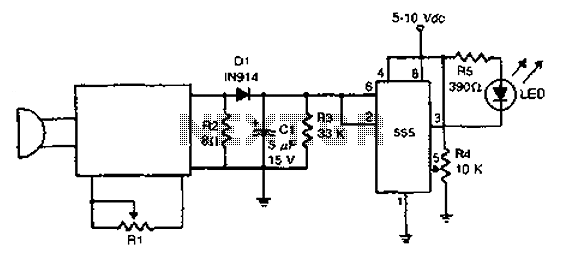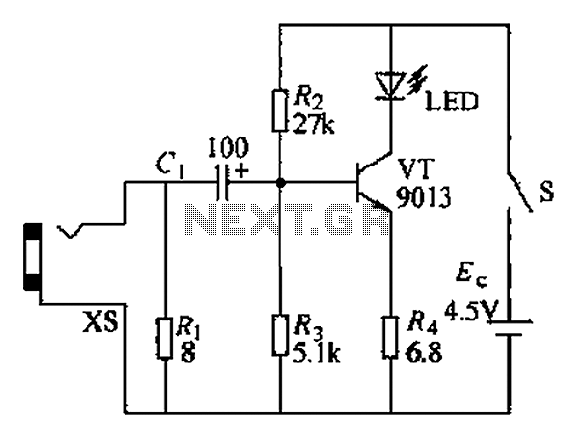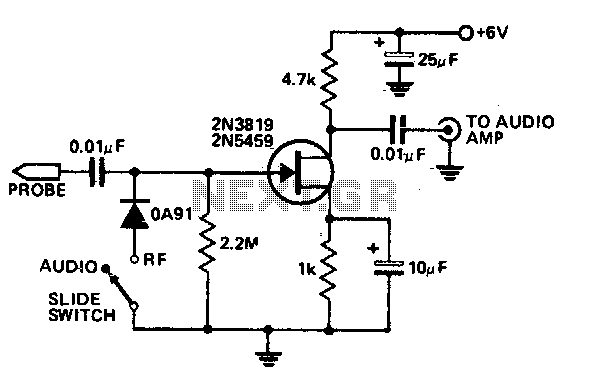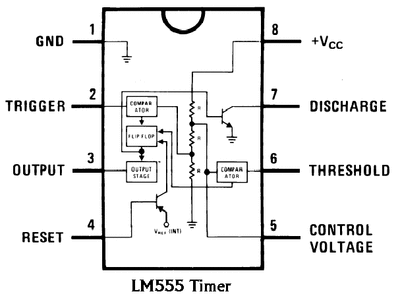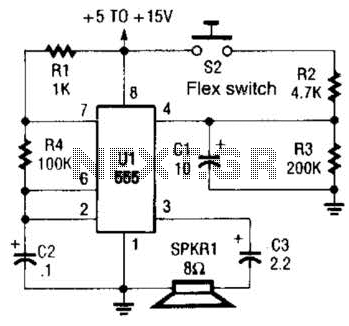
Logic Probe With Sound
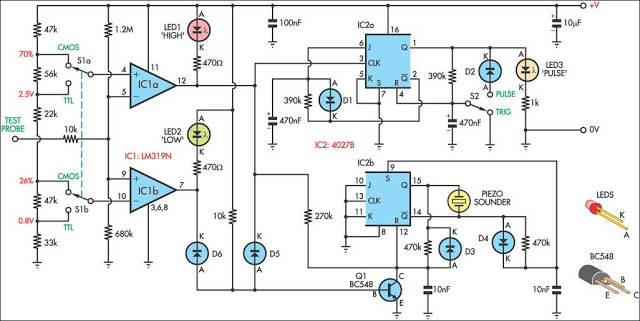
This logic probe can be selected to operate on TTL or CMOS logic levels, depending on switch S1. A string of resistors associated with switch S1 sets the threshold levels for a window comparator comprising IC1a and IC1b. Depending on whether the level applied to the probe is high or low, the window comparator turns on LED1 (high) or LED2 (low). The 1.2M and 680k resistors set the probe signal to a midrange value when the probe is open-circuit, thereby preventing either LED from being lit. If a pulse signal is present, the output of IC1a will toggle the clock input of flip-flop IC2a. This drives LED3, which either lights for each pulse or continuously, depending on the setting of switch S2. Finally, the outputs of IC1a and IC1b are connected by diodes D5 and D6 to the base of transistor Q1, which is connected to the Reset input of flip-flop IC2b. This has a piezo sounder (not a buzzer) connected between its Q and Q-bar outputs, so that it produces a sound that echoes the input pulse signal.
This logic probe circuit is designed to provide visual and auditory feedback for digital logic levels, accommodating both TTL (Transistor-Transistor Logic) and CMOS (Complementary Metal-Oxide-Semiconductor) logic families. The operation begins with the selection of logic type via switch S1, which influences the threshold levels established by a resistor network. The two resistors, 1.2MΩ and 680kΩ, are crucial in determining the midrange voltage at the probe when it is open-circuit, ensuring that neither LED is illuminated under these conditions.
The core of the circuit is the window comparator, formed by operational amplifiers IC1a and IC1b. This comparator monitors the voltage level at the probe and activates LED1 when a high logic level is detected and LED2 for a low logic level. The output from IC1a is also pivotal as it triggers the clock input of flip-flop IC2a when a pulse signal is present, allowing for dynamic response to incoming signals.
LED3 serves as an additional visual indicator, configured to either blink with each pulse or remain continuously lit, depending on the configuration of switch S2. This feature enhances the probe's functionality by providing real-time feedback on signal activity.
The outputs from the window comparator are routed through diodes D5 and D6 to the base of transistor Q1. This transistor functions as a switch, controlling the Reset input of flip-flop IC2b. The flip-flop is responsible for generating an audible output through a piezo sounder connected between its Q and Q-bar outputs. This design choice allows the circuit to produce a sound that corresponds to the input pulse signal, providing an auditory indication of logic states and transitions.
Overall, this logic probe circuit effectively combines visual and auditory indicators to facilitate the analysis of digital signals, making it a valuable tool for electronics troubleshooting and development.This logic probe can be selected to operate on TTL or CMOS logic levels, depending on switch S1. A string of resistors associated with switch S1 sets the threshold levels for a window comparator comprising IC1a and IC1b. Depending on whether the level applied to the probe is high or low, the window comparator turns on LED1 (high) or LED2 (low).
Th e 1. 2M and 680k resistors set the probe signal to a midrange value when the probe is open-circuit, thereby preventing either LED from being lit. If a pulse signal is present, the output of IC1a will toggle the clock input of flipflop IC2a. This drives LED3 which either lights for each pulse or continuously, depending on the setting of switch S2.
Finally, the outputs of IC1a & IC1b are connected by diodes D5 & D6 to the base of transistor Q1 which is connected to the Reset input of flipflop IC2b. This has a piezo sounder (not buzzer) connected between its Q and Q-bar outputs so that it produces a sound which echoes the input pulse signal.
🔗 External reference
This logic probe circuit is designed to provide visual and auditory feedback for digital logic levels, accommodating both TTL (Transistor-Transistor Logic) and CMOS (Complementary Metal-Oxide-Semiconductor) logic families. The operation begins with the selection of logic type via switch S1, which influences the threshold levels established by a resistor network. The two resistors, 1.2MΩ and 680kΩ, are crucial in determining the midrange voltage at the probe when it is open-circuit, ensuring that neither LED is illuminated under these conditions.
The core of the circuit is the window comparator, formed by operational amplifiers IC1a and IC1b. This comparator monitors the voltage level at the probe and activates LED1 when a high logic level is detected and LED2 for a low logic level. The output from IC1a is also pivotal as it triggers the clock input of flip-flop IC2a when a pulse signal is present, allowing for dynamic response to incoming signals.
LED3 serves as an additional visual indicator, configured to either blink with each pulse or remain continuously lit, depending on the configuration of switch S2. This feature enhances the probe's functionality by providing real-time feedback on signal activity.
The outputs from the window comparator are routed through diodes D5 and D6 to the base of transistor Q1. This transistor functions as a switch, controlling the Reset input of flip-flop IC2b. The flip-flop is responsible for generating an audible output through a piezo sounder connected between its Q and Q-bar outputs. This design choice allows the circuit to produce a sound that corresponds to the input pulse signal, providing an auditory indication of logic states and transitions.
Overall, this logic probe circuit effectively combines visual and auditory indicators to facilitate the analysis of digital signals, making it a valuable tool for electronics troubleshooting and development.This logic probe can be selected to operate on TTL or CMOS logic levels, depending on switch S1. A string of resistors associated with switch S1 sets the threshold levels for a window comparator comprising IC1a and IC1b. Depending on whether the level applied to the probe is high or low, the window comparator turns on LED1 (high) or LED2 (low).
Th e 1. 2M and 680k resistors set the probe signal to a midrange value when the probe is open-circuit, thereby preventing either LED from being lit. If a pulse signal is present, the output of IC1a will toggle the clock input of flipflop IC2a. This drives LED3 which either lights for each pulse or continuously, depending on the setting of switch S2.
Finally, the outputs of IC1a & IC1b are connected by diodes D5 & D6 to the base of transistor Q1 which is connected to the Reset input of flipflop IC2b. This has a piezo sounder (not buzzer) connected between its Q and Q-bar outputs so that it produces a sound which echoes the input pulse signal.
🔗 External reference
